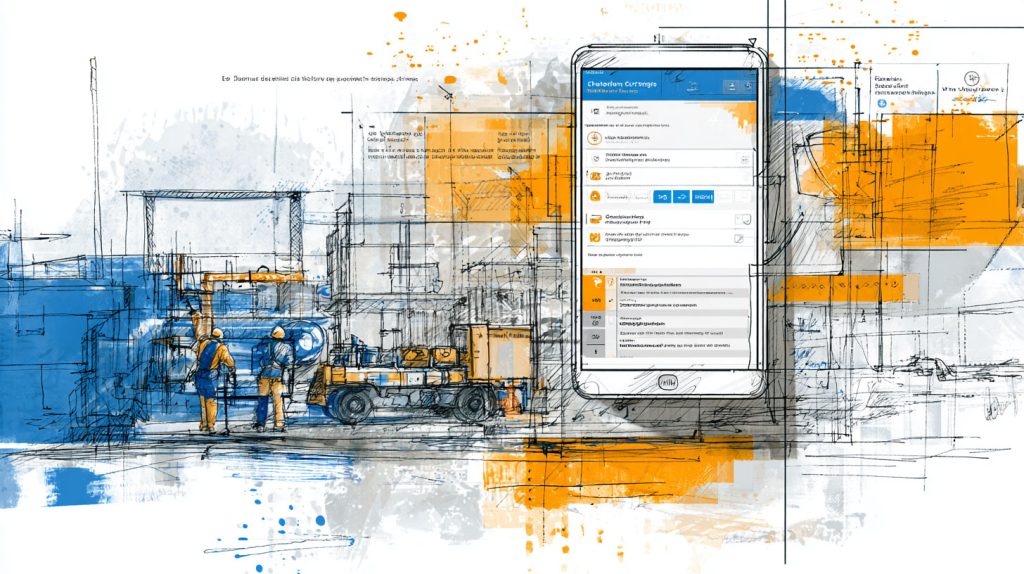Best Guide to Pre-Task Plans in Construction: What Every Superintendent Should Expect From the Crew Daily
Table of Contents:

Every safe, efficient jobsite starts with one habit: the daily pre-task plan. Whether you call it a PTP, TAKE 5, or daily task analysis, it’s the crew’s opportunity to pause, think, and align before lifting tools or stepping into live work zones. For superintendents and field leaders, pre-task plans are more than paperwork—they’re the pulse check on how well teams understand their work, the associated risks, and how to mitigate them.
Yet, not all pre-task plans are created equal. Some are rushed checkboxes filled out just to satisfy compliance, while others become powerful tools that prevent incidents, improve coordination, and set the tone for disciplined execution. The difference comes down to culture, clarity, and consistency—and that’s where technology and leadership intersect.
Today’s superintendents expect more than a clipboard with signatures. With StruxHub Forms, digital pre-task plans bring visibility, accountability, and data analytics to the process. Supervisors can review completed plans in real time, identify recurring hazards, and ensure corrective actions are logged and tracked. Integrated with StruxHub Schedule and Home, PTPs evolve from static paperwork into dynamic communication tools that strengthen safety, productivity, and crew alignment.
This guide breaks down how to make pre-task planning a cornerstone of site management—what superintendents should expect daily, how to standardize procedures, and how StruxHub helps streamline the process from the field to the office.
Why Pre-Task Planning Is the Foundation of Field Safety and Efficiency
A strong pre-task plan serves two purposes: it prepares crews for safe execution and synchronizes field activities with the day’s goals. Before a crew starts work, they should review what tasks are being performed, who is involved, what tools and materials are needed, and what hazards could arise. When done correctly, it’s a short meeting that can prevent hours—or even days—of delay.
Superintendents rely on these daily reviews to assess situational awareness and gauge crew readiness. They can spot knowledge gaps, resource shortages, or coordination issues early. Pre-task plans also reinforce accountability—when crews identify their own hazards and controls, they take ownership of safety outcomes.
By digitizing this process through StruxHub Forms, all data flows directly into dashboards. Superintendents can monitor completion rates, track recurring hazards, and measure compliance trends over time. AI-assisted insights flag potential patterns, such as frequent issues with confined spaces or electrical isolation, enabling proactive coaching.
How should crews complete an effective PTP?
- Define the exact task scope for the day.
- Identify associated hazards and mitigation steps.
- Assign individual responsibilities and sign off as a group.
Why does this matter for superintendents?
- It ensures visibility into field readiness, task clarity, and hazard awareness.
What trends are improving pre-task planning?
- Mobile reporting, AI hazard detection, and integrated scheduling data.
Top Features
- Digital PTP templates linked to work packages
- Real-time completion tracking via dashboards
- Automatic hazard category tagging
Top Benefits
- Improved communication and hazard recognition
- Measurable safety performance
- Fewer incidents and stoppages
Best Practices
- Review PTPs during the morning safety huddle
- Encourage crew input instead of top-down direction
- Use analytics to highlight training needs
FAQ
Q: Why are pre-task plans required daily?
A: Because job conditions change daily—each new task brings new hazards.
Q: How does digital tracking help?
A: It enables superintendents to monitor compliance instantly and identify repeat issues.
When pre-task planning becomes part of the crew’s rhythm, safety and productivity rise together.
Related StruxHub articles
- Top Ways AI and Modern Pre-Task Plan (PTP) Platforms Use Smart Data to Improve Safety and Jobsite Coordination
- How Can Superintendents Make Sure Every Crew Completes a Pre-Task Plan (PTP) Before Starting Work Each Day?
- Top Reasons to Switch From Paper Pre-Task Plans to a Digital Construction Safety Platform
- Best Guide to Geographic Information Systems (GIS) in Construction: How Location-Based Data Improves Construction Project Management
Internal links used: https://struxhub.com/products/forms/ • https://struxhub.com/products/home/ • https://struxhub.com/resources/blog/

How Superintendents Should Review and Validate Pre-Task Plans
The most effective pre-task plans are reviewed—not just completed. A superintendent’s role is to verify that the crew’s plan actually addresses the work ahead, not to rubber-stamp a generic checklist. Reviewing PTPs in the morning gives superintendents insight into whether crews fully understand their tasks and hazards.
When pre-task plans are submitted digitally through StruxHub Forms, superintendents can validate them remotely, leave notes, or request clarifications instantly. They can also attach photos or reference related documents from StruxHub Home, like schedules or permits. This ensures that daily plans are aligned with the overall project timeline and site logistics.
Consistency is key. Each plan should reflect the actual conditions of that day—weather, trade overlap, or material changes. By tracking daily compliance across crews, superintendents can identify which teams consistently deliver quality PTPs and which require additional supervision or training.
How should superintendents review PTPs effectively?
- Confirm that hazards and mitigations are specific, not generic.
- Cross-check planned work against current scheduling and deliveries.
Ensure signatures reflect all involved workers.
What problems does this process solve?
- It prevents incomplete or outdated task reviews from compromising safety.
How does digital workflow improve review quality?
- Automated submission timestamps and sign-offs verify authenticity.
Top Features
- Superintendent comment and review tools
- Automatic reminders for missing submissions
- Linked scheduling and document references
Top Benefits
- Clear accountability and audit-ready documentation
- Faster communication between field and management
- Reduced errors and oversights
Best Practices
- Review PTPs daily before major work begins
- Provide feedback to crews consistently
- Track trends to target coaching and improvement
FAQ
Q: How long should a superintendent spend reviewing PTPs?
A: Typically 5–10 minutes per crew, depending on task complexity.
Q: What if a crew submits incomplete information?
A: Return it digitally for correction before approving work to begin.
Reviewing pre-task plans isn’t red tape—it’s the simplest, most effective way to keep crews aligned and protected.
Related StruxHub articles
- Top Construction Pre-Task Plan (PTP) Software Features Every Superintendent Should Use to Keep Crews Aware and Safe
- How Do Superintendents Use Pre-Task Plans (PTPs) to Keep Crews Safe and Productive on the Jobsite?
- Best Guide to Construction Risk Management: How Top Contractors Control Jobsite Risk and Improve Field Accountability
- How Superintendents Use AI-Enhanced Tools to Improve Jobsite Communication
Internal links used: https://struxhub.com/products/forms/ • https://struxhub.com/products/home/

Linking Pre-Task Plans to Scheduling, Permits, and Deliveries
Pre-task planning doesn’t happen in isolation—it must align with the day’s scheduled work, deliveries, and site access conditions. When a crew completes their PTP, it should directly reference scheduled activities and corresponding permits. Without this connection, teams risk starting work before the site is ready or without required clearances.
By integrating PTPs with StruxHub Schedule and Deliveries, superintendents can verify that every task aligns with live site logistics. For example, if a material delivery is delayed, the system automatically flags the crew’s task as “pending” until the necessary components arrive. Similarly, if a high-risk task requires a permit-to-work, it can be attached digitally to the PTP.
This integration creates a feedback loop—task planning informs scheduling, and scheduling validates readiness. It also ensures city inspectors or safety officers can view live documentation during audits, eliminating the need to chase paperwork.
How does integration streamline task coordination?
- Links task plans to real-time schedule phases.
- Ensures all dependencies and permits are verified before work begins.
- Provides automatic alerts for conflicting or delayed activities.
What benefits does this create for owners and contractors?
- Predictable progress, cleaner documentation, and fewer stoppages.
What tools make this possible?
- StruxHub’s interconnected modules for schedule, deliveries, and forms.
Top Features
- Linked task planning to logistics and delivery data
- Auto-permit verification workflow
- Live dependency tracking between crews
Top Benefits
- Prevents premature starts and rework
- Improves coordination across trades
- Enhances audit and compliance readiness
Best Practices
- Require permit validation before approving PTPs
- Reference schedule IDs in all daily plans
- Use automated alerts for material or weather delays
FAQ
Q: How do connected systems improve scheduling accuracy?
A: They ensure that crews only begin work when materials, access, and permits are confirmed.
Q: Can inspectors access digital PTPs during reviews?
A: Yes—authorized users can view all task documentation through StruxHub’s dashboard.
When PTPs are tied to schedules and logistics, your site operates as one synchronized system, not isolated silos.
Internal links used: https://struxhub.com/products/schedule/ • https://struxhub.com/products/deliveries/ • https://struxhub.com/products/forms/
Using Data and AI to Improve Pre-Task Planning Quality
Digital pre-task plans don’t just record information—they generate valuable data. When captured consistently, that data reveals patterns that help superintendents make better operational decisions. Trends like recurring hazards, high-risk tasks, or crews with repeated late submissions all tell a story about field discipline, training gaps, and safety culture.
By using StruxHub Forms, each pre-task plan becomes a data point. Over time, AI analytics can surface insights—highlighting the most common hazard categories or days with elevated risk based on overlapping activities. When paired with StruxHub Schedule, it can even correlate incidents or delays with specific task types or project phases.
This visibility empowers leaders to act before problems escalate. Safety managers can target high-risk crews for additional coaching, and superintendents can adjust sequencing to minimize congestion. Owners benefit too—they see measurable improvement over time, proving that your team manages risk proactively rather than reactively.
How can AI enhance pre-task planning?
- Detects repetitive hazards or late submissions.
- Predicts peak-risk days based on task overlap and weather.
- Automates safety alerts for recurring issues.
Why is data analytics valuable for superintendents?
- It helps them see trends across weeks or phases, not just individual days.
What are the future trends?
- Integration with predictive risk scoring and real-time hazard mapping.
Top Features
- AI-driven analysis of hazard frequency and categories
- Trend dashboards by trade, zone, or time period
- Automated alerts for overdue or incomplete PTPs
Top Benefits
- Stronger safety oversight without manual tracking
- Early detection of training or coordination issues
- Better alignment with owner safety metrics
Best Practices
- Review analytics weekly with foremen and safety teams
- Use dashboards to guide toolbox talks
- Reward crews with consistent, high-quality submissions
FAQ
Q: How does AI identify risk trends?
A: It analyzes completed forms for patterns in hazard types, timing, and task overlap.
Q: Can analytics reduce incident rates?
A: Yes—by surfacing recurring issues early, leaders can intervene before an accident occurs.
When data and AI join the safety conversation, pre-task planning evolves from reactive compliance to predictive prevention.
Related StruxHub articles
- Best Guide to Mission-Critical Construction: How to Coordinate and Schedule Hyperscale Data Center Builds
- Mission-Critical Construction: Managing Safety, Workforce, and Permitting Challenges in Hyperscale Data Center Construction
Internal links used: https://struxhub.com/products/forms/ • https://struxhub.com/products/schedule/
Managing Accountability and Communication Across Crews
A pre-task plan is only as good as the accountability behind it. In large projects, dozens of crews submit PTPs every morning. Without structure and follow-up, those plans can easily lose meaning. Superintendents must ensure each crew not only completes their plan but reviews it in person, confirms understanding, and updates it when conditions change.
Digital tools simplify this process. StruxHub Home consolidates every active PTP in one view, showing completion status, time submitted, and superintendent sign-off. Color-coded indicators highlight overdue or missing plans, while automated reminders keep crews on schedule. StruxHub Forms can even require photo verification—proof that a physical huddle occurred.
This level of accountability strengthens communication between trades. When every team completes a clear plan before work starts, cross-trade awareness improves. Superintendents can quickly identify conflicts, such as overlapping access paths or concurrent high-risk activities, and resolve them before incidents occur.
How do digital systems improve accountability?
- Track submission time, crew leader, and location automatically.
- Record electronic sign-offs and comments.
- Store completed forms in a searchable audit archive.
Why does this matter?
- It builds a consistent culture of preparation, transparency, and shared responsibility.
How can crews communicate more effectively?
- Combine daily pre-task reviews with short coordination huddles between adjacent trades.
Top Features
- Centralized PTP dashboard with color-coded tracking
- Mobile signatures and photo validation
- Integration with scheduling and safety reports
Top Benefits
- Full visibility of all daily safety documentation
- Better coordination between trades and supervisors
- Streamlined audits and performance reviews
Best Practices
- Require digital submissions before 7:00 a.m.
- Use dashboards to verify completion each morning
- Follow up with crews that miss submissions twice in one week
FAQ
Q: How do digital PTPs enhance communication?
A: Everyone—from safety to scheduling—sees the same live documentation in one place.
Q: What’s the biggest challenge?
A: Ensuring crews understand PTPs are for their safety, not just compliance paperwork.
Clear accountability turns the pre-task plan from a form into a habit—one that drives daily discipline across the jobsite.
Related StruxHub articles
- How Superintendents Manage Power, Cooling, and Equipment Coordination in Hyperscale Data Center Projects
- Best Guide to Construction Logistics Plans (CLPs): What Owners Want to See Before Work Starts
- What Is a Site Utilization Plan in Construction and Why Does It Matter for Safety and Productivity?
Internal links used: https://struxhub.com/products/home/ • https://struxhub.com/products/forms/
StruxHub
Discover how StruxHub can revolutionize your construction management. Contact us today!
Using Pre-Task Plans to Drive Continuous Improvement and Safety Culture
Pre-task planning isn’t just about preventing accidents—it’s about building a consistent culture of communication, foresight, and trust. When every crew treats pre-task reviews as part of their craft, the site runs smoother, morale improves, and leadership can focus on progress rather than firefighting.
By capturing data digitally through StruxHub Forms, safety managers can track trends over time and convert them into actionable training. For example, if electrical hazards appear in multiple submissions, you can hold a targeted safety meeting. If weather delays repeatedly impact scaffold work, planners can adjust schedules and mitigation strategies through StruxHub Schedule.
This continuous feedback loop creates measurable improvement. Over time, PTP completion rates increase, incident frequency drops, and owner confidence grows. The best firms even include summarized PTP metrics in monthly progress reports to showcase proactive safety leadership.
How can teams sustain long-term safety improvement?
- Review PTP trends weekly in safety meetings.
- Incorporate lessons learned into future work plans.
- Recognize crews for proactive hazard identification.
What KPIs matter most?
- PTP completion rates, recurring hazard categories, and time-to-correct metrics.
How does digital tracking influence culture?
- It reinforces accountability and provides tangible proof that safety is prioritized.
Top Features
- Multi-project analytics dashboard
- Trend reporting across trades or time periods
- Integration with scheduling and risk metrics
Top Benefits
- Reduced incidents and near misses
- Stronger collaboration between field and management
- Tangible proof of continuous improvement for owners
Best Practices
- Review trends monthly with leadership and owners
- Use PTP data to shape future training initiatives
- Publish safety highlights on internal dashboards
FAQ
Q: How can PTPs shape company culture?
A: They turn safety into a daily conversation rather than a compliance event.
Q: What measurable outcomes come from consistent planning?
A: Higher productivity, fewer stoppages, and improved crew engagement.
Pre-task plans aren’t just safety paperwork—they’re the foundation of a proactive, accountable, and continuously improving jobsite culture.
Related StruxHub articles
- Best Guide to Creating a Construction Site Utilization Plan with GIS Mapping, AI, and Logistics Tools
- What’s the Difference Between Geographic Information Systems (GIS), BIM, and CAD in Construction Projects?
- Why Construction Superintendents Are Turning to Geographic Information Systems (GIS) for Smarter Field Operations
Internal links used: https://struxhub.com/products/forms/ • https://struxhub.com/products/schedule/ • https://struxhub.com/resources/blog/

StruxHub
Experience the power of StruxHub today and witness firsthand how it can revolutionize your construction operations.
How StruxHub Supports Contractors and Superintendents with Daily Pre-Task Planning
Superintendents already have enough to juggle—coordinating crews, deliveries, inspections, and schedule milestones. StruxHub makes one of the most important daily rituals—the pre-task plan—faster, smarter, and fully connected to your project workflow.
With StruxHub Home, you get a clear view of every crew’s daily submissions in one centralized dashboard. Each pre-task plan completed through StruxHub Forms updates in real time, showing which crews are compliant, which tasks are approved, and where follow-up is needed. Digital signatures, timestamps, and photo attachments create a verifiable record for audits and daily briefings.
Integration with StruxHub Schedule links each plan directly to scheduled activities, ensuring every PTP aligns with the day’s actual work plan. If deliveries or access routes change, StruxHub Deliveries automatically updates dependencies, keeping the entire site synchronized.
This end-to-end system transforms pre-task planning into a continuous improvement loop—turning data into insights that drive safer and more efficient field operations. For project managers, it’s proof of control; for crews, it’s a daily habit that reinforces accountability; for owners, it’s visible evidence that their project is being managed with precision and care.
With StruxHub, project teams gain real-time visibility, clear communication, and the confidence to deliver every build on schedule and without compromise to safety.
Internal links used:
https://struxhub.com/products/home/
https://struxhub.com/products/forms/
https://struxhub.com/products/schedule/
https://struxhub.com/products/deliveries/
https://struxhub.com/resources/blog/





